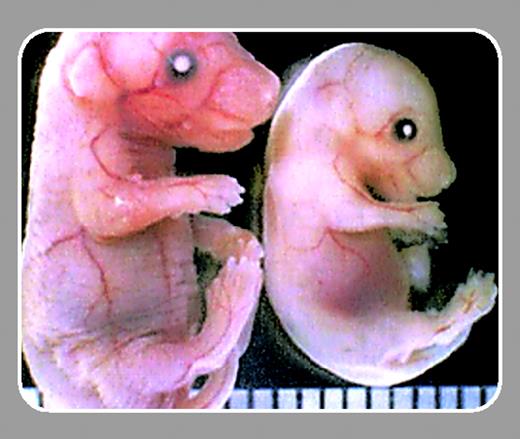HEMATOPOIESIS
Fetal macrophages associate intimately with developing erythroid cells and thymocytes, removing discarded nuclei and apoptotic cells in fetal liver and thymus. The phosphatidyl serine receptor (PSR) originally defined by Fadok et al1 plays an essential role in ingestion of corpses, as shown by Kunisaki and colleagues (page 3362) in this issue of Blood. PSR-/- mice die perinatally, with severe blocks in definitive erythropoiesis and thymocyte development. The authors hypothesize that phagocytic clearance may be reciprocally linked to cell differentiation and programmed death, as also suggested by recent studies in Caenorhabditis elegans2 and in murine lung and brain.3
It is not generally appreciated that resident macrophages perform poorly understood trophic functions during hemopoiesis in the adult as well as in the fetus.4 Stromal macrophages in bone marrow, for example, express nonphagocytic adhesion molecules for erythroblasts and developing neutrophils, whilst avidly ingesting extraded erythrocyte nuclei and apoptotic leukocytes. Their potential ability to express and secrete factors that control hemopoietic cell growth and differentiation has not been sufficiently studied. It is not clear from the published studies whether macrophage development is also defective in PSR knockout mice, although diminished phagocytosis of apoptotic cells by existing macrophages is clearly evident. Conversely, macrophages can express death-inducing surface receptors and secretory products. The present study shows that excessive production of proinflammatory cytokines such as tumor necrosis factor α (TNF-α) is unlikely to contribute to the mortality of PSR-deficient mice.
An important question that is not fully addressed in the present paper is whether defective apoptosis accompanies diminished clearance and abnormal differentiation. Whilst the emphasis here is on hemopoiesis, other studies suggest the interactions between developing cells, apoptosis, and phagocyte removal are more widespread in tissues, although not universal.3
Many plasma membrane receptors have now been shown to contribute to binding and ingestion of apoptotic cells by macrophages, although in cases such as scavenger receptor A deficiency, the resultant phenotype is less marked, with minimal impact, if any, on apoptosis and differentiation5 but more on inflammation. The role of PSR in cell-cell interactions is of a special nature, which should teach us more about the linkage between death and differentiation on the one hand and clearance of apoptotic cells on the other.


This feature is available to Subscribers Only
Sign In or Create an Account Close Modal